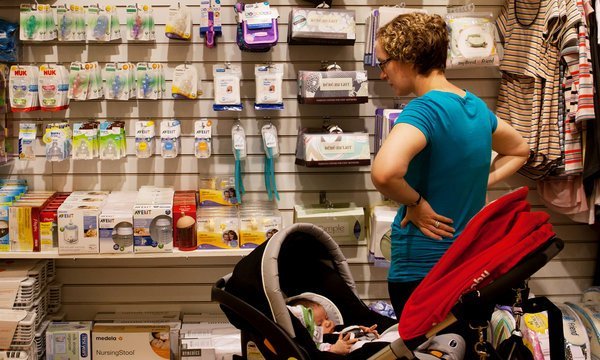
By Jessica Grose
Underneath Yummy Mummy’s cheerful purple awning on Lexington Avenue between 81st and 82nd Streets, a mannequin wearing a Boob brand striped nursing top has one breast peeking out. The cheeky tableau announces the shop’s mission as clearly as the slogan stenciled on the door: “Happy breastfeeding.”

Equal parts upscale boutique and Duane Reade, the bright, well-organized space offers new and expectant mothers practical nursing necessities and a little necessary pampering for their breasts. And with products like Nummies brand nursing bras, goat’s rue herbal supplements (to increase breast milk production) and Earth Mama nipple butter, it can be hard to tell which is which.
The store’s pumps, mostly made by Medela, camouflage their medical-equipment origins in smooth molded plastic and rubber-duckie yellow. A “pump in style” rig — if a backpack counts as stylish on the Upper East Side — runs the new mother $299; the “freestyle,” which clips onto her belt like an engorged BlackBerry, costs $379. Hospital-grade pumps are available for rental, as well.
On a recent early Thursday afternoon, a woman sat on a plush couch in the back to nurse her infant daughter while early Michael Jackson played in the background. She had just bought some nipple shields — small pieces of silicone that can make breast-feeding easier for infants. The store’s owner, Amanda Cole, lent her a hot-pink patterned pillow to strap around her waist to support the baby. Soon, her daughter was happily sucking away, and the woman was chatting with Ms. Cole about how her older son was adjusting to the new addition to the family.
In the Manhattan work-life ballet, doing what comes naturally can get pretty complicated. So when Ms. Cole, 36, opened the store in 2009, the idea was to offer nursing mothers both products and instruction: breast-feeding classes, prenatal yoga and events like “doula speed dating,” in which expectant parents can meet and choose a labor coach.
“When I first had to use my breast pump,” Ms. Cole recalled, “I called my sister, who luckily lived across the street, and I was like, ‘Get over here, I have no idea what to do, this apparatus is so scary.’ ”
The shop serves local professionals and stay-at-home moms and receives a steady stream of business from women visiting obstetricians affiliated with Lenox Hill Hospital nearby. On this Thursday, one woman arrived with her husband and baby in tow. The man stood uncomfortably amid the maternal miscellany while the woman tried on a series of nursing-friendly nightgowns in blue and black.
“They always feel like they’re the first dad that’s ever come in here,” Ms. Cole observed.
By 6 p.m., most of the shoppers had drifted out, and the women attending the evening’s prenatal breast-feeding class started to trickle in. Wendy Schwartz, who lives on the Upper West Side, was expecting her second child in two weeks and had come for a refresher. “We didn’t think we’d have another,” she said. “So we threw everything out and forgot everything.”
The class’s teacher, Kate Sharp, has been a lactation consultant for 24 years, and she projected a tidy and confident air. She wore very sensible shoes.
She put in a DVD, and the screen displayed a newborn scooting toward her mother’s breast without any help. Ms. Sharp turned off the sound (“goofy childbirth music,” she sniffed), but told the class to watch how the baby instinctively made her way to the food source.
Ms. Sharp had a baby doll dressed in a red onesie that she used to show the class proper positioning. She leaned back against her chair with the doll propped against her chest to show how easily a baby could be supported.
“Just do this,” she said, offering advice as old as motherhood itself, “and you’ll feel like a magician.”
See the article on the New York Times website…



